|
|
Our Holy Mother, the Martyr Eudocia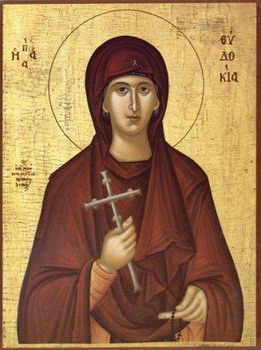 Living in Heliopolis, a city of Phoenicia, during the reign of Trajan, she was at first a great harlot, then a penitent, a nun and finally a martyr. She gained great wealth from her harlotry. The reversal of her life was brought about, through the providence of God, by an elderly monk, Germanus, and that unintentionally. Coming to Heliopolis in the course of his work, he stayed at the house of a Christian woman whose home abutted onto Eudocia"s. When at night he began, as was his monastic custom, to read the Psalter and a book on the Dreadful Judgement, Eudocia heard him and stood listening attentively to his every word until the end. Fear and dread took such hold on her that she remained awake until daybreak. As soon as it was dawn, she sent a servant to beg that monk to come to her. Germanus came, and they began a long conversation on that which the old monk had been reading the previous night, and especially on faith and salvation. The result of these discussions was that Eudocia asked the local bishop to baptise her. After her baptism, she gave all her goods to the church, to be distributed to the poor, dismissed her servants and slaves and retired to a women"s monastery. She so devoted herself to the monastic life - to obedience, patience, vigils, prayer and fasting - that after thirteen months she was chosen as abbess. She lived fifty-six years in the monastery and was worthy in the eyes of God to be given the gift of raising the dead. When a persecution of Christians arose under the governor, Vincent, holy Eudocia was beheaded. Here is a wonderful example of how a vessel of uncleanness can be purified, sanctified and filled with a precious, heavenly fragrance by the grace of the Holy Spirit. Living in Heliopolis, a city of Phoenicia, during the reign of Trajan, she was at first a great harlot, then a penitent, a nun and finally a martyr. She gained great wealth from her harlotry. The reversal of her life was brought about, through the providence of God, by an elderly monk, Germanus, and that unintentionally. Coming to Heliopolis in the course of his work, he stayed at the house of a Christian woman whose home abutted onto Eudocia"s. When at night he began, as was his monastic custom, to read the Psalter and a book on the Dreadful Judgement, Eudocia heard him and stood listening attentively to his every word until the end. Fear and dread took such hold on her that she remained awake until daybreak. As soon as it was dawn, she sent a servant to beg that monk to come to her. Germanus came, and they began a long conversation on that which the old monk had been reading the previous night, and especially on faith and salvation. The result of these discussions was that Eudocia asked the local bishop to baptise her. After her baptism, she gave all her goods to the church, to be distributed to the poor, dismissed her servants and slaves and retired to a women"s monastery. She so devoted herself to the monastic life - to obedience, patience, vigils, prayer and fasting - that after thirteen months she was chosen as abbess. She lived fifty-six years in the monastery and was worthy in the eyes of God to be given the gift of raising the dead. When a persecution of Christians arose under the governor, Vincent, holy Eudocia was beheaded. Here is a wonderful example of how a vessel of uncleanness can be purified, sanctified and filled with a precious, heavenly fragrance by the grace of the Holy Spirit.Our Holy Father AgapiusA novice with a staretz near the monastery of Vatopedi, he was captured by pirates and sold as a slave in Magnesia. After twelve years he was miraculously freed and returned to Vatopedi by the aid of the most holy Mother of God. He baptised his former owner and became his confessor. Spending the rest of his life in asceticism at Vatopedi, he departed this life peacefully in the Lord.
The Holy Martyr Antonina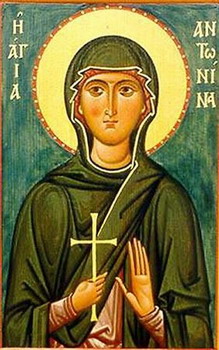 Born in Nicaea, she was arrested and harshly tortured for the Christian faith. She was finally sewn into a sack and thrown into a lake in 302, but God saved her soul and glorified her forever among the angels in heaven and among the faithful on earth. Born in Nicaea, she was arrested and harshly tortured for the Christian faith. She was finally sewn into a sack and thrown into a lake in 302, but God saved her soul and glorified her forever among the angels in heaven and among the faithful on earth.Virginmartyr Domnina of Syria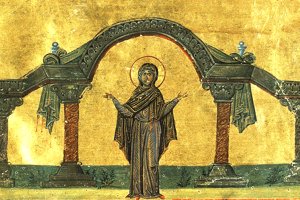 The Virgin Domnina of Syria was a disciple of St Maron (February 14). the nun built a straw-covered hut in her mother’s garden and lived there as an ascetic, eating only lentils soaked in water.
Each morning and evening she went to church, covered in a veil so that no one ever saw her face. The voice of the nun, in the words of her biographer Theodoret of Cyrrhus, was “resonant and expressive, and her words were always accompanied by tears.” The holy ascetic peacefully fell asleep in the Lord between 450-460. The Virgin Domnina of Syria was a disciple of St Maron (February 14). the nun built a straw-covered hut in her mother’s garden and lived there as an ascetic, eating only lentils soaked in water.
Each morning and evening she went to church, covered in a veil so that no one ever saw her face. The voice of the nun, in the words of her biographer Theodoret of Cyrrhus, was “resonant and expressive, and her words were always accompanied by tears.” The holy ascetic peacefully fell asleep in the Lord between 450-460. Martyrs Charisius, Nicephorus, and AgapiusHoly Martyrs Nestor and TribiminusThe Holy Martyrs Nestor and Tribiminus were natives of the Asia Minor district of Pamphylia. They fearlessly preached Christ during a persecution in the reign of the impious emperor Decius (249-251).
When the saints were brought before the pagan court, the governor ordered that all sorts of instruments of torture be placed before them in order to frighten them and force them to renounce the Christian Faith. The saints replied that no one could separate them from Christ.
Saints Marcellus and Anthony of Syria
Martyrs Sophronius and Silvester
New Martyr Paraskevas of Trebizond (1659)
Venerable Martyrius of Zelenets, Pskov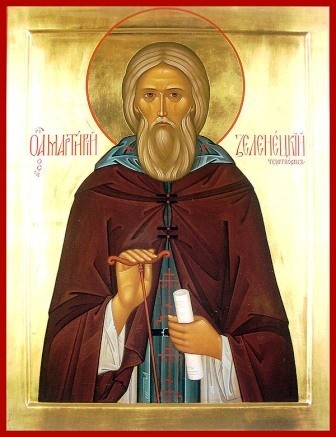 Saint Martyrius of Zelenets, in the world Menas, was born in the city of Veliki Luki (Great Meadow) in the sixteenth century. His parents, Cosmas and Stephanida, died when he was just ten years old. He was raised by his spiritual Father, a priest of the city’s Annunciation church, and the child’s soul cleaved to God. Saint Martyrius of Zelenets, in the world Menas, was born in the city of Veliki Luki (Great Meadow) in the sixteenth century. His parents, Cosmas and Stephanida, died when he was just ten years old. He was raised by his spiritual Father, a priest of the city’s Annunciation church, and the child’s soul cleaved to God.Saint David of Wales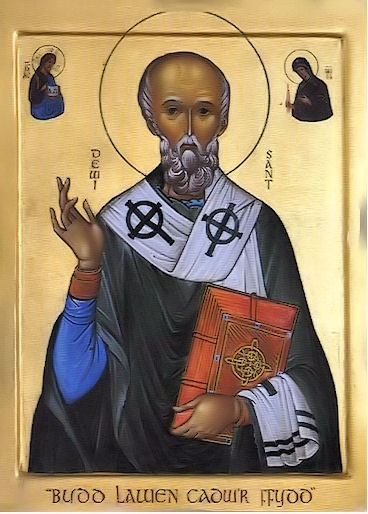 Our father among the saints David of Wales (ca. 512-587), known in Welsh as Dewi Sant, was a 6th century bishop and monastic founder in Wales and is its patron saint. He is also known as the Dewi Ddyfrwr (David the Water Drinker) due to his drinking only water and the founding of many holy wells associated with his life. His feast day in the Church is March 1.
Much of our information on the early history of Saint David comes from two sources: the 11th/12th century hagiography Buchedd Dewi (Life of David) of Rhigyfarch and the 12th-century writings of Giraldus Cambrensis (Gerald of Wales). David was a descendant of the royal house of Cunedda. Rhigyfarch wrote that David was the son of Sanctus Rex Ceredigionis, where Sanctus has been interpreted as a proper name and its owner honoured by Welsh Christians as Saint Sant. The Latin phrase itself translates as "a holy king of Ceredigion." The king of Ceredigion in the 510s was Gwyddno Garanhir, according to regional tradition. His title Garanhir ("crane legs"), certainly indicated spiritual accomplishment to the Druids who bestowed it. If the son of King Gwyddno, David was a grandson of King Ceredig, and a nephew of King Maelgwn of Gwynedd, and a brother of Elphin the successor to the Kingdom of Ceredigion and the foster-father and first patron of the bard Taliesin. Little is known of his mother, Non (honoured by Welsh Christians as Saint Non), though she is said to have been the daughter of a local chieftain - some versions of the meeting of Sant (or Gwyddno) and Non state that Sant forced himself upon Non.
David was born on a stormy night at or near Capel Non (Non's chapel) within a short walk of the present day city of Saint David's. The ruins of the medieval chapel are visible near the site, and a nearby well is still a site of pilgrimage. He was baptised by the Irish monk St. Elvis, and educated at the monastery of Hen Fynyw. After ordination, David was taught by the elderly monk Paulinus, whose blindness the young David healed by making the sign of the cross over the monk's eyelids.
He became renowned as a teacher and preacher, founding monasteries in Britain and Brittany (on the west coast of modern France), in a period when neighbouring tribal regions (that were to be united as England three hundred years later) were still mostly pagan. He rose to a bishopric, and presided over two synods, as well as going on pilgrimages to Jerusalem where he was anointed as a bishop by the patriarch.
St. David's Cathedral now stands on the site of the monastery he founded in southwest Pembrokeshire; in early medieval Britain this part of Wales was located near several important Celtic sea routes, and was not nearly as remote as it might seem today. A shrine to Saint David, containing his bones, the bones of his spiritual father Saint Justinian of Ramsey Island, and possibly those of Saint Caradoc, is located within the cathedral.
The Monastic Rule of David prescribed that monks had to pull the plow themselves without draught animals; to drink only water; to eat only bread with salt and herbs; and to spend the evenings in prayer, reading and writing. No personal possessions were allowed: to say "my book" was an offence. He taught his followers to fast, especially refraining from eating meat or imbibing alcohol. His symbol, also the symbol of Wales, is the leek.
The best-known miracle associated with St. David is said to have taken place on an occasion when he was preaching in the middle of a large crowd. When those at the back complained that they could not see or hear him, the ground on which he stood is reputed to have risen up to form a small hill so that everyone had a good view. The village which is said to stand on the spot today is known as Llanddewi Brefi. A more mundane version of this story is that he simply recommended that the synod participants move to the hilltop.
One of Rhigyfarch's aims in the Buchedd Dewi was that his document could establish some independence for the Welsh church, which was risking losing its independence following the Norman invasion of England in 1066. It is significant that David is said to have denounced Pelagianism during the incident before the ground rose beneath him. Giraldus Cambrensis, the nephew of a Bishop of St. David's similarly hoped to demonstrate the ancient independence of the see as the archbishopric of an independent Welsh church; he was himself nominated for the position of Bishop of St. David's on at least three occasions, but was turned down by Henry II initially and the Archbishop of Canterbury subsequently after the accession of John.
William of Malmesbury recorded that David visited Glastonbury intending to dedicate the abbey there, as well as to donate a travelling altar including a great sapphire. He had a vision there of Jesus Christ who said that "the church had been dedicated long ago by Himself in honour of His Mother, and it was not seemly that it should be re-dedicated by human hands." So David instead commissioned an extension to be built to the abbey, east of the Old Church. (The dimensions of this extension given by William were archaeologically verified in 1921.) One manuscript indicates that a sapphire altar was among the items King Henry VIII confiscated from the abbey at its dissolution a thousand years later. There are unverifiable indications that the sapphire may now be among the Crown Jewels of the United Kingdom.
His last words, according to the Buchedd Dewi, were: "Be steadfast, brothers, and do the little things." Our father among the saints David of Wales (ca. 512-587), known in Welsh as Dewi Sant, was a 6th century bishop and monastic founder in Wales and is its patron saint. He is also known as the Dewi Ddyfrwr (David the Water Drinker) due to his drinking only water and the founding of many holy wells associated with his life. His feast day in the Church is March 1.
Much of our information on the early history of Saint David comes from two sources: the 11th/12th century hagiography Buchedd Dewi (Life of David) of Rhigyfarch and the 12th-century writings of Giraldus Cambrensis (Gerald of Wales). David was a descendant of the royal house of Cunedda. Rhigyfarch wrote that David was the son of Sanctus Rex Ceredigionis, where Sanctus has been interpreted as a proper name and its owner honoured by Welsh Christians as Saint Sant. The Latin phrase itself translates as "a holy king of Ceredigion." The king of Ceredigion in the 510s was Gwyddno Garanhir, according to regional tradition. His title Garanhir ("crane legs"), certainly indicated spiritual accomplishment to the Druids who bestowed it. If the son of King Gwyddno, David was a grandson of King Ceredig, and a nephew of King Maelgwn of Gwynedd, and a brother of Elphin the successor to the Kingdom of Ceredigion and the foster-father and first patron of the bard Taliesin. Little is known of his mother, Non (honoured by Welsh Christians as Saint Non), though she is said to have been the daughter of a local chieftain - some versions of the meeting of Sant (or Gwyddno) and Non state that Sant forced himself upon Non.
David was born on a stormy night at or near Capel Non (Non's chapel) within a short walk of the present day city of Saint David's. The ruins of the medieval chapel are visible near the site, and a nearby well is still a site of pilgrimage. He was baptised by the Irish monk St. Elvis, and educated at the monastery of Hen Fynyw. After ordination, David was taught by the elderly monk Paulinus, whose blindness the young David healed by making the sign of the cross over the monk's eyelids.
He became renowned as a teacher and preacher, founding monasteries in Britain and Brittany (on the west coast of modern France), in a period when neighbouring tribal regions (that were to be united as England three hundred years later) were still mostly pagan. He rose to a bishopric, and presided over two synods, as well as going on pilgrimages to Jerusalem where he was anointed as a bishop by the patriarch.
St. David's Cathedral now stands on the site of the monastery he founded in southwest Pembrokeshire; in early medieval Britain this part of Wales was located near several important Celtic sea routes, and was not nearly as remote as it might seem today. A shrine to Saint David, containing his bones, the bones of his spiritual father Saint Justinian of Ramsey Island, and possibly those of Saint Caradoc, is located within the cathedral.
The Monastic Rule of David prescribed that monks had to pull the plow themselves without draught animals; to drink only water; to eat only bread with salt and herbs; and to spend the evenings in prayer, reading and writing. No personal possessions were allowed: to say "my book" was an offence. He taught his followers to fast, especially refraining from eating meat or imbibing alcohol. His symbol, also the symbol of Wales, is the leek.
The best-known miracle associated with St. David is said to have taken place on an occasion when he was preaching in the middle of a large crowd. When those at the back complained that they could not see or hear him, the ground on which he stood is reputed to have risen up to form a small hill so that everyone had a good view. The village which is said to stand on the spot today is known as Llanddewi Brefi. A more mundane version of this story is that he simply recommended that the synod participants move to the hilltop.
One of Rhigyfarch's aims in the Buchedd Dewi was that his document could establish some independence for the Welsh church, which was risking losing its independence following the Norman invasion of England in 1066. It is significant that David is said to have denounced Pelagianism during the incident before the ground rose beneath him. Giraldus Cambrensis, the nephew of a Bishop of St. David's similarly hoped to demonstrate the ancient independence of the see as the archbishopric of an independent Welsh church; he was himself nominated for the position of Bishop of St. David's on at least three occasions, but was turned down by Henry II initially and the Archbishop of Canterbury subsequently after the accession of John.
William of Malmesbury recorded that David visited Glastonbury intending to dedicate the abbey there, as well as to donate a travelling altar including a great sapphire. He had a vision there of Jesus Christ who said that "the church had been dedicated long ago by Himself in honour of His Mother, and it was not seemly that it should be re-dedicated by human hands." So David instead commissioned an extension to be built to the abbey, east of the Old Church. (The dimensions of this extension given by William were archaeologically verified in 1921.) One manuscript indicates that a sapphire altar was among the items King Henry VIII confiscated from the abbey at its dissolution a thousand years later. There are unverifiable indications that the sapphire may now be among the Crown Jewels of the United Kingdom.
His last words, according to the Buchedd Dewi, were: "Be steadfast, brothers, and do the little things." |